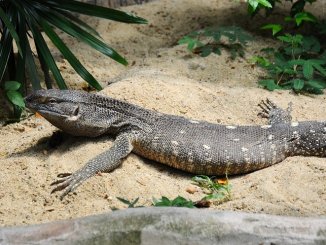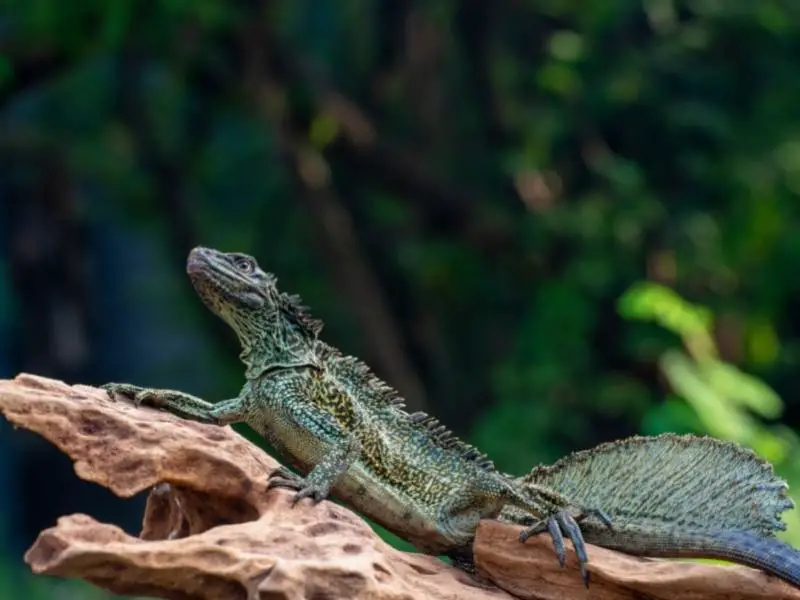
The sailfin dragon is a large, striking lizard hailing from New Guinea, the Philippines, and some parts of Eastern Indonesia. Sailfin dragons have timid, skittish personalities and a dinosaur-like appearance.
Caring for a sailfin dragon is moderately challenging because the lizard requires a large, semi-arboreal enclosure and doesn’t tolerate poor enclosure conditions.
Sailfin Dragon Overview
| Common name | Sailfin dragon, sailfin lizard, Philippine sailfin dragon |
| Scientific name | Hydrosaurus microlophus and Hydrosaurus amboinensi |
| Natural habitat | Tropical regions of New Guinea, the Philippines, and eastern Indonesia |
| Adult size | 35–42 inches |
| Average lifespan | 20–25 years |
| Diet | Omnivore |
| Housing | Minimum 30 gallons, 75–115°F, 75%–80% humidity |
| Experience | Intermediate |
Origin
The sailfin dragon is native to southern New Guinea, eastern Indonesia, and the Philippine Islands. The lizard’s natural habitat is silty rivers in tropical forests. Sailfin dragons spend most of their time basking in or near the water, climbing tree branches, and foraging for leaves, fruits, insects, and small animals in their densely vegetated environment.
Sailfin dragons are diurnal, meaning that they have a standard day-to-night cycle and sleep under rocks and logs at night.
Appearance and Behavior
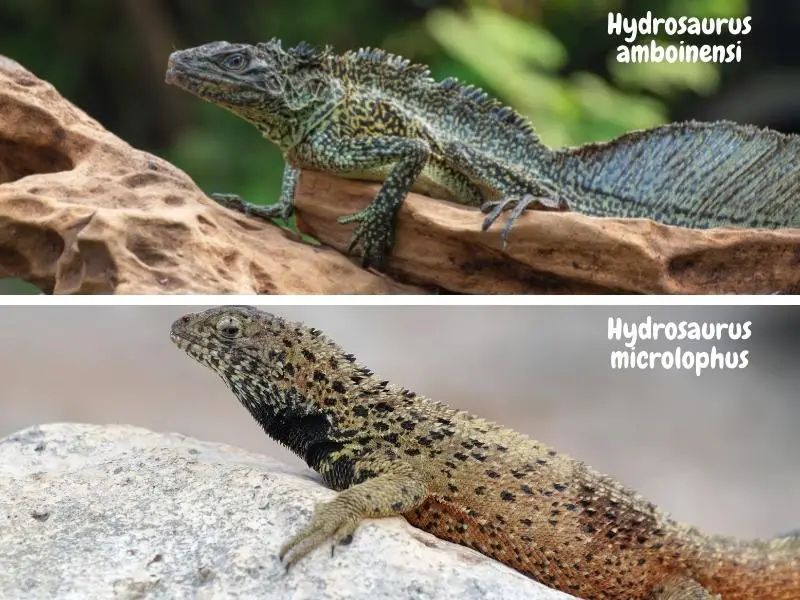
The sailfin dragon has a prehistoric, dinosaur-like appearance, with a girthy body and a well-defined crest extending from the back of the head down the neck. The lizard has a row of spiky scales beginning at the nape of its neck and ending at the bottom of its back.
Sailfin dragons have long tails, and agile legs with elongated toes. Most lizards of this species are gray or green, with mottled patterning that creates a natural camouflage. Some lizards are found in more exotic shades of red, black, or brown, with blue accents around the face, chest, and legs.
Male sailfin dragons have the characteristic sail — a large, fan-like feature with sturdy rays that enable it to stand up on command. The sail protrudes from the base of the tail and is used for temperature control, balance, swimming, and attracting females. Males also have bigger heads and darker limbs than females.
Size and Lifespan
The average length of a sailfin dragon is 35–42 inches. The lizard’s exact length varies depending on the subspecies. Indonesian giants and Philippine sailfin dragons are the two largest subspecies. The Weber’s sailfin is about 10 inches shorter than the other subspecies.
Sailfin dragons have a long average lifespan of around 25 years. Lizards that are housed in a clean, well-maintained enclosure and fed a nutritious diet are likely to live longer than lizards that aren’t properly cared for.
Temperament
The Sailfin dragon is a nervous, skittish lizard that runs and hides at any sign of potential danger. It’s common for sailfin dragons to display anxious behavior for the first one or two years of life in captivity, but once the lizards become used to their environment, they’re easygoing and low-hassle to care for.
Sailfin dragons can coexist with each other, as long as the enclosure is large enough to house multiple lizards. To avoid conflict and territorial behavior, pair two females or one female and one male. These lizards don’t enjoy being handled and are known to scratch, whip their tails, and try to escape if they’re handled.
Housing Sailfin Dragons
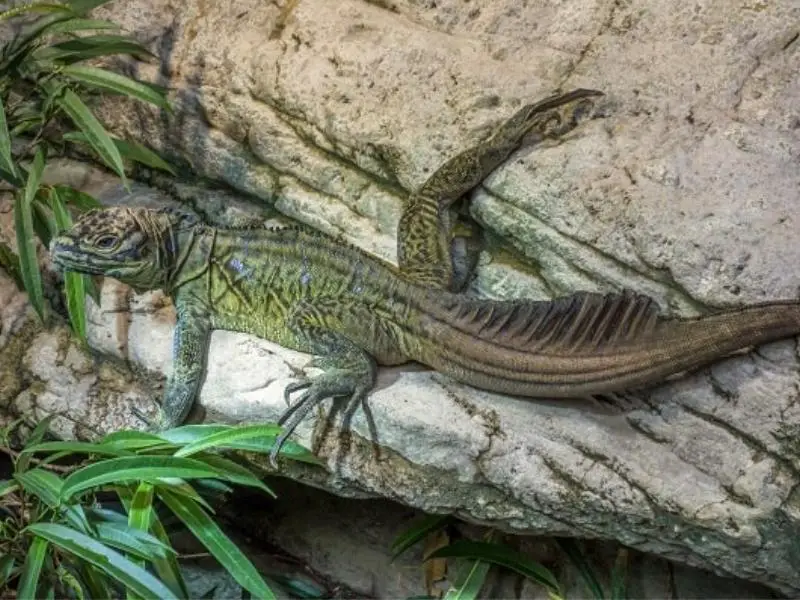
The sailfin dragon’s natural habitat is shallow streams and rivers in hot, humid forests in tropical regions all over the world. Provide a similar environment in captivity to help the lizard feel at home in its new home.
Keep sailfin dragons in a large glass gecko terrarium or vivarium.
Enclosure size
The minimum enclosure size for a sailfin dragon is 30 gallons. 50 gallons is the ideal enclosure size for an adult lizard of this species. Sailfin geckos enjoy climbing, so the enclosure should be at least 60 inches tall. The ideal tank length and width is 60 inches by 30 inches.
Lighting
Sailfin dragons are a diurnal species and need a standard day-to-night cycle. Place the enclosure in a room that gets plenty of access to natural sunlight during the day, and keep the enclosure in darkness for at least eight hours overnight. If you want to keep an eye on your lizard at night, install a red lamp.
Install a full-spectrum UVB light to stimulate the sun’s rays in the lizard’s natural environment. UVB is essential for sailfin dragons to synthesize calcium, which is used to build and maintain bones in the body and support metabolic functions.
Install the light above the top of the enclosure and set it on a timer to shine during daylight hours.
Temperature and Humidity
Sailfin dragons need a temperature gradient in the enclosure to thermoregulate (maintain a steady internal body temperature). In their natural habitat, the lizards move to warmer or cooler areas to adjust their temperature accordingly. Mimic the different temperatures in the wild by providing hot spots and cool spots in the enclosure.
There are two temperatures to aim for in the enclosure:
- A basking area of around 115°F
- An ambient temperature (for the rest of the enclosure) of 80–90°F
Set up a basking light above a high branch that the lizard can comfortably sit on. Install the light outside of the enclosure to prevent the bulb from burning the lizard.
Overnight, allow temperatures to drop to 75°F, but no lower. Install heat strips or emitters if your room temperature drops below 75°F overnight.
Monitor temperatures with a thermometer to ensure your enclosure’s climate accurately mimics the lizard’s natural habitat.
The ideal humidity for a sailfin dragon enclosure is 75–80%. Use a hygrometer to measure humidity levels and increase humidity by misting the enclosure when necessary. Usually, if the enclosure temperature is correct, the water and plants in the enclosure should maintain humidity without the need for additional misting.
Substrate and Decoration
The best substrate for a sailfin dragon enclosure is an easy-to-clean, moisture-absorbing material like cypress mulch. Add sphagnum moss to the mix for its antibacterial and antifungal properties. Avoid fine substrates that could get stuck around your lizard’s eyes.
In the wild, sailfin lizards live near streams and are semi-arboreal, so they should have plenty of water-dwelling and climbing space in the enclosure.
Add a series of branches to the enclosure that offer numerous horizontal and diagonal climbing routes. Choose branches of varying thickness, ensuring that all branches are sturdy enough to support the lizard. Built-in climbing shelves can be used to provide additional climbing space at the top of the enclosure.
Provide foliage with real or artificial plants around the enclosure. Ensure that you have enough plants to offer shade and hiding spots while leaving enough open space for the lizard to move around.
Place a hide box in a shaded part of the enclosure for the lizard to retreat to when it feels nervous.
Cleaning
Routine cleaning is essential to preventing your sailfin lizard from getting sick in captivity. Spot-clean the enclosure every day, replacing soiled parts of the substrate and washing out and refilling the water bowl.
Deep-clean the enclosure about once a month. Remove the substrate and all the decorations from the enclosure and place the lizard in a temporary enclosure. Use a sponge dipped in warm water to wipe down the enclosure walls and floor and soak the decorations in equal parts warm water and white vinegar. Wipe the leaves of live plants with a damp cloth. Add a fresh layer of substrate, then rinse, dry, and return the decorations to the enclosure.
Consider setting up a bioactive enclosure to reduce your cleaning responsibilities. A bioactive enclosure includes live plants and small insects, like springtails and woodlice. In a functional setup, the insects break down the lizard’s waste products, minimizing the need for cleaning the enclosure.
Sailfin Dragon Care
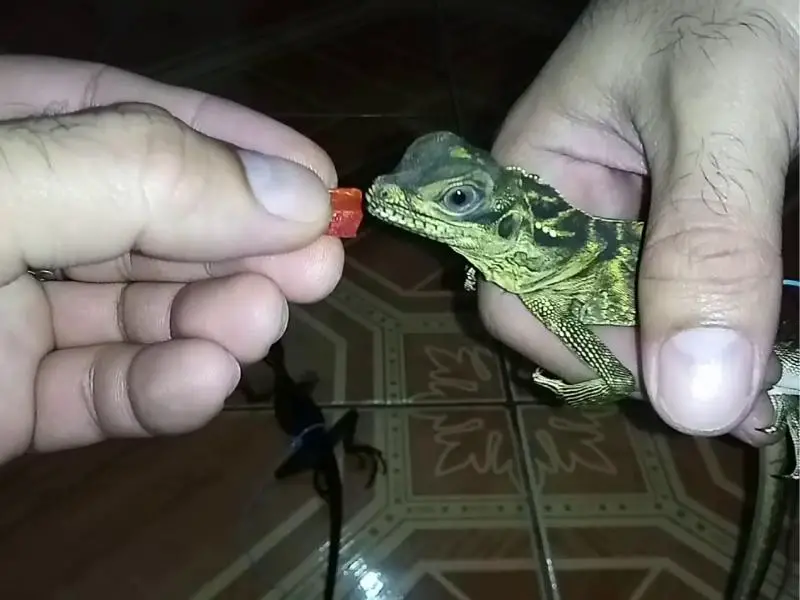
Caring for sailfin dragons is moderately difficult. These large lizards have big appetites and are prone to disease if they’re not looked after properly.
Food and Water
In the wild, sailfin dragons eat insects, leaves, flowers, fruits, and small animals. Replicate this varied omnivorous diet in captivity by providing a combination of protein-rich insects and plant-based foods.
Good protein-rich sailfin dragon food options are cockroaches, crickets, earthworms, super worms, small crustaceans, and feeder mice. Make sure that insects are cleaned and gut-loaded before feeding. Dust the foods with calcium and vitamin D3 supplement powders to boost their nutritional value.
Plant-based food sources for sailfin dragons are kale, squash, carrots, dandelion greens, berries, and bananas.
Feed adult sailfin dragons every other day. Young lizards of this species should be fed 75% protein (like calcium-dusted insects and super worms) and 25% plant matter (like chopped-up kale) once or twice a day.
Give your sailfin dragon lizard constant access to water by providing a large water bowl in the enclosure. The bowl should be big enough for the lizard to climb into and soak. Wash out the water bowl every day to prevent a buildup of bacteria.
Handling
Most sailfin dragons are nervous lizards that don’t tolerate handling and will try their best to escape. Sailfin dragon handling should be limited to essential scenarios, such as transferring the lizard to a new enclosure or performing a health check.
Some lizards of this species become more comfortable with handling over time. Gain your lizard’s trust by moving slowly and quietly around them. Children shouldn’t handle sailfin dragons.
To correctly handle a sailfin dragon, scoop up the lizard and support its body with both of your hands. Don’t try to chase or catch the lizard because this will make the lizard nervous in your presence.
Common Health Issues
Sailfin dragons are prone to common health issues affecting lizards in captivity. Most of these health issues can be avoided by properly caring for the lizard, providing a healthy diet, limiting stress, and keeping the enclosure clean.
Respiratory Infections
Respiratory infections are caused by viruses, parasites, bacteria, or fungi. Symptoms of a respiratory infection include discharge from the eyes and nose, wheezing, open-mouthed or shallow breathing, breathing, and lethargy. Speak to a veterinarian about prescribing antibiotics or other medications to treat the infection depending on its source. Reduce the risk of infections by maintaining clean, correctly heated tank conditions.
Internal Parasites and Diseases
Most sailfin dragons are wild-caught, which means they’re prone to internal parasites and diseases from their natural habitat. Make sure to properly quarantine your lizard for at least 90 days and arrange for a veterinary check-up to avoid spreading parasites to your pets, other lizards, or family members. Ask your veterinarian for recommended reptile parasite treatments if necessary.
Physical Injuries
Sailfin dragons are at risk of physical injuries. Abrasive substrates or substrates with small particles may damage the lizard’s eyes, leading to infections. The lizards also have a habit of rubbing their snouts on solid decorations and walls. Prevent your lizard from rubbing on sharp wire mesh by installing a tall footer along the bottom of the enclosure. Treat serious physical injuries with immediate veterinary care.
Breeding
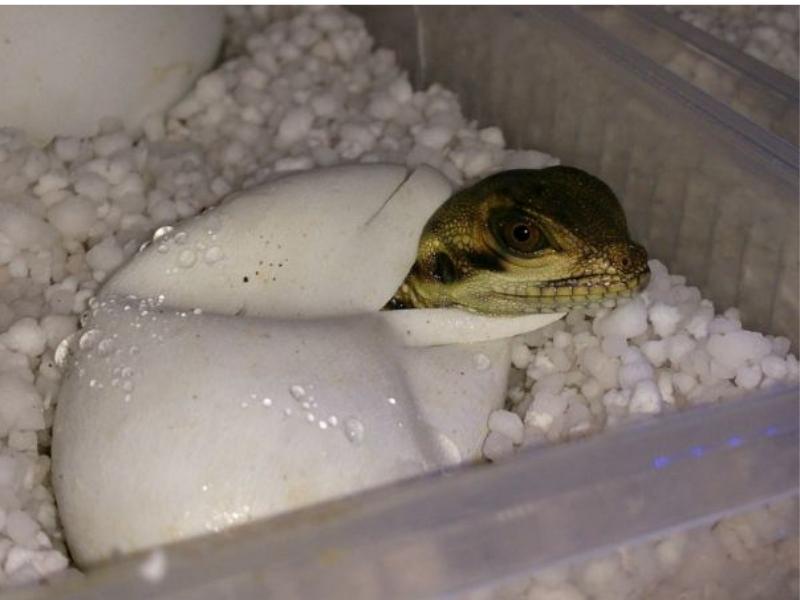
There are few reports of successfully breeding sailfin dragons in captivity because females have no maternal instincts and mimicking the rainy season in the enclosure is difficult.
The lizards reach sexual maturity at 3.5 to 4 years old. In the wild, Females lay 1 clutch of two to eight eggs per breeding season (February to July). These eggs hatch during the rainy season.
There is limited information on how to breed sailfin dragons online. Several breeding tips, which may increase your likelihood of success, are:
- Increase the female’s calcium intake to encourage her to ovulate
- Provide a dirt-like substrate for the female to lay eggs
- Once the eggs are laid, incubate them at about 83°F for two months
Choosing and Buying a Sailfin Dragon
The average cost of a sailfin dragon is $100 to $200. Sailfin dragons are difficult to breed, so they’re not widely available in the commercial pet trade. The lizards were listed as an endangered species in the Philippines in the early 1990s, so they’re no longer exported from this country. The main source of exported sailfin lizards today is Indonesia.
To find a healthy sailfin dragon for sale, look online for reputable breeders. Before you spend your money, ask to see pictures and videos of the lizard (or arrange to see the lizard in person if possible). Check that the lizard has smooth skin, bright eyes, and good eating habits. Don’t buy a lizard if you notice discharge from the eyes or nose, unusual breathing, or lumps, bumps, or open wounds on the skin.

